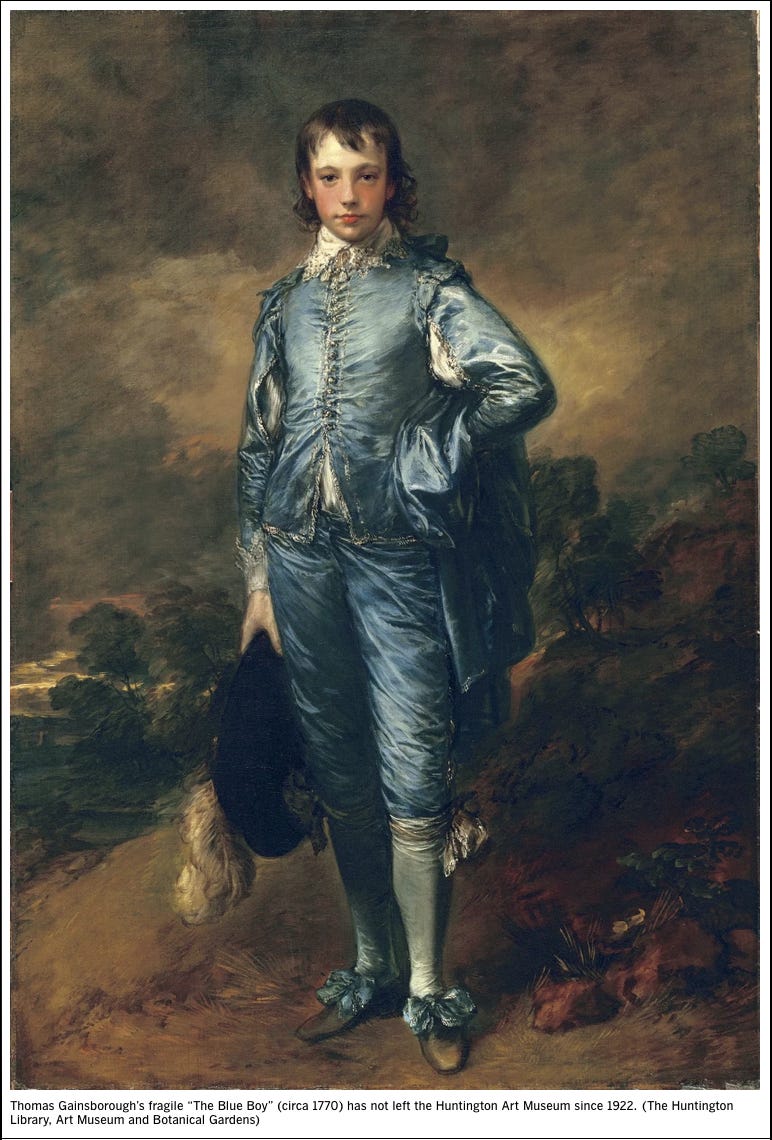Un-Bridging the Gap
The Huntington Library's "Blue Boy" should probably sit this one out as institutional admin and conservators disagree on its first loan in 100 years.
“Despite the expert panel’s warning, the museum then secured the loan arrangement. No loan fee is being charged, but an as-yet unannounced reciprocal loan has been guaranteed to the Huntington from the National Gallery.”
Christopher Knight writes in the Los Angeles Times about the loaning of the Huntington Library’s “Blue Boy” by Thomas Gainsborough to Britain’s National Gallery in London. Loans are a normal institutional practice, of course, but this one (and surely many others like it) raise many yellow flags and exemplify the disconnect between collections care professionals and the upper administration that I know some of my colleagues feel.
I will not summarize the article, but know that the work has not traveled since its purchase a century ago, that 8 conservators from all over the world examined it and unanimously declared it unfit for travel, that it underwent a minimally invasive, 3-year restoration in 2018 based on the fact that it would not travel.
The administration of the Huntington Library declined to comment on the reasons for the temporary repatriation against an eager current of expert opinion, though we know that a comparable, yet-undeclared loan will go the other way. The press release states:
“This masterpiece has made an indelible mark on both art history and popular culture, capturing the imaginations of a wide range of audiences,” said Karen R. Lawrence, Huntington President. “Given The Blue Boy’s iconic status at The Huntington, this is an unprecedented loan, one which we considered very carefully. We hope that this partnership with the National Gallery will spark new conversations, appreciation, and research on both sides of the Atlantic.”
I allow for the fact that genuinely good reasons for the loan could exist, but on the face of things, it looks like the Huntington places the care of the collection below other factors. Those factors, “new conversations, appreciation, and research,” are very soft, too, as opposed to increased income – the diamond-level hard of factors – which does not seem to directly result from this transaction. The Blue Boy has become a prodigal son returning to its homeland exactly 100 years since it left to plead again for appreciation.
My question: Does the promise of this partnership with the National Gallery tip the scales in favor of the loan and away from the protection of the object? Also, will this set a precedent for other institutions? Maybe the Huntington decided that the significance of the 100-year anniversary was the best pickup line they had heard in, well, 100 years, and thus merits a one-off risk? Perhaps, additional conservation while away accompanys the loan? Perhaps it is all about the reciprocal loan going the other way. We just do not know.
Based on what we have read pubicly, the incoming loan from the National Gallery seems stand like an elephant on the scale with the protection Blue Boy like a feather on the other side. What loan could possibly value more than the health of your institution’s most iconic work? And, will that loan generate blockbuster publicity and/or subsequent revenue that justify the action?
To be sure, the Blue Boy’s itinerary has already generated publicity for the institutions involved. I want to follow it because it publicly displays what happens regularly in collections and museums: administrators overule those charged with maintaining the health of the objects. When something happens to the object, collections care profesionals have to fix the forecasted problem. I understand that it is never that straightforward, though, but I think you see the point. They unreasonably overule our expertise.
Collections care professionals such as conservators, registrars, and preparators make their way in their profession with a chip on their shoulder assuming a curator or director will pull rank over their professional advice. As one of them, I admit that our community can sometimes make unreasonable demands for care that require regular compromise to promote the accessibility mandated by institutional mission.
Ultimately, however, the opaque decision-making confounds those charged with executing the orders and protecting the collections like a general deploying troops against an enemy they know they cannot defeat. If the Huntington’s administration decided to permit this loan for relatable reasons, why not state it instead of driving a wedge deeper in this relationship? The lack of transparency only leads to degenerative speculation and more disjointed institutional relationships. The other long-game solution requires the ascendence of collections care professionals to upper administration in order to make the decisions themselves.
If you have further insight on the situation at the Huntington or in general, please leave a comment below.


